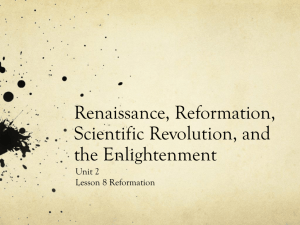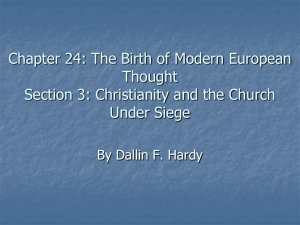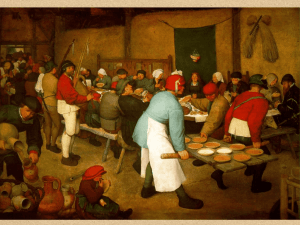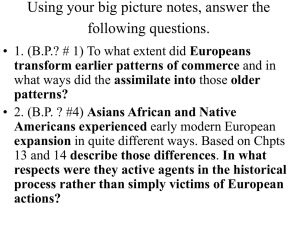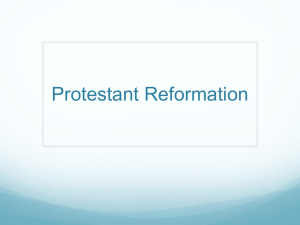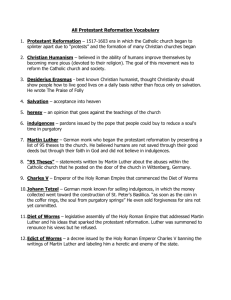Christianity was an - Spokane Public Schools
advertisement
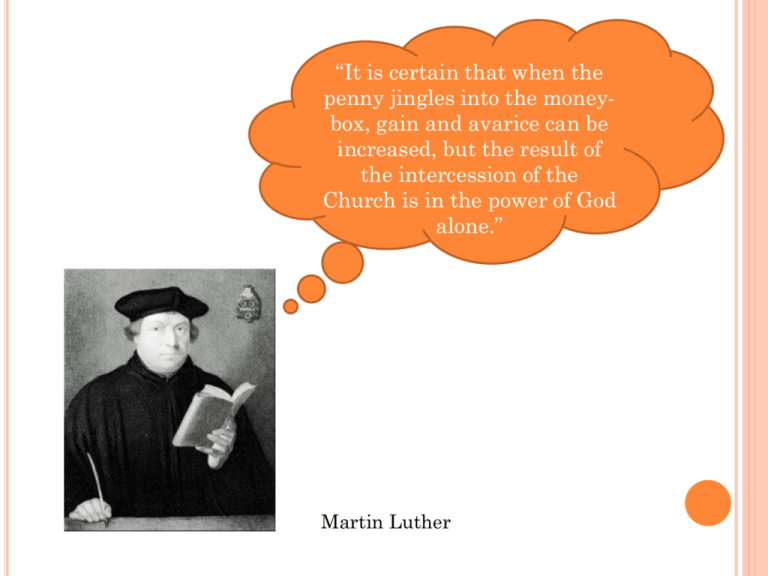
“It is certain that when the penny jingles into the moneybox, gain and avarice can be increased, but the result of the intercession of the Church is in the power of God alone.” Martin Luther In the early sixteenth century, the Protestant Reformation shattered the unity of Roman Catholic Christianity For 1,000 years, the Roman Catholic Church had provided the cultural and organizational foundation of Western European civilization The Reformation began in 1517 when a German priest, Martin Luther, publicly invited debate about various abuses within the Roman Catholic Church Luther had posted a document, known as the Ninety-five Theses, on the door of a church in Wittenberg It was nothing new in that many people criticized the luxurious life of the popes, corruption and immorality of some clergy, and the selling of indulgences Indulgences were said to remove the penalties for sin. But what made Luther’s protest revolutionary was its theological basis. Luther had come to a new understanding of salvation, which held that salvation came through faith alone. Neither the good works of the sinner nor the sacraments of the Church had any bearing on the eternal destiny of the soul, for faith was a free gift of God, graciously granted to his needy and undeserving people. To Luther, the source of these beliefs, and of religious authority in general, was not the teaching of the Church, but the Bible alone, interpreted according to the individual’s conscience Luther challenged the authority of the Church and called into question the special position of the clerical hierarchy and of the pope in particular Contrary to Luther’s original intentions, his ideas ultimately provoked a massive schism within the world of Catholic Christendom Some kings and princes found in Luther’s ideas a justification for their own independence and an opportunity to gain the lands and taxes previously held by the Church The Protestant idea that all vocations were of equal merit appealed to middle-class urban dwellers. It provided a new religious legitimacy for their growing role in society since the Roman Catholic Church was associated in their eyes with the rural and feudal world of aristocratic privilege. For common people offended by the corruption and luxurious living of some clergy, the new religious ideas served to express their opposition to the entire social order, particularly in a series of German peasant revolts in the 1520s. Although large numbers of women were attracted to Protestantism, Reformation teachings and practices did not offer them a greater role In Protestant-dominated areas, the veneration of Mary and female saints ended, leaving the male Christ figure as the sole object of worship Protestant opposition to celibacy and monastic life closed the convents, which offered an alternative to marriage Nor were Protestants (except the Quakers) any more willing than Catholics to offer women an official role within their churches The importance that Protestants gave to reading the Bible for oneself stimulated education and literacy for women but with little opportunity for women to use their education Reformation thinking spread quickly within and beyond Germany due to the recent invention of the printing press by Johann Gutenberg and Luther’s translation of the New Testament into German. But as the movement spread, it splintered into a variety of competing Protestant churches – Lutheran, Calvinist, Anglican, Quaker, Anabaptist – many of which subsequently subdivided. For more than thirty years (1562-1598), French society was torn by violence between Catholics and the Protestant minority known as Huguenots On August 24, 1572, Catholic mobs in Paris massacred some 3,000 Huguenots, and thousands more perished in provincial towns in the weeks that followed Finally, Henry IV issued the Edict of Nantes (1598) granting a measure of religious toleration to French Protestants with the intention they would soon return to the Catholic Church The culmination of European religious conflict took shape in the Thirty Years’ War (16181648), a Catholic-Protestant struggle that began in the Holy Roman Empire but eventually engulfed Europe It was a destructive war with estimates between 15 and 30 percent of the German population perishing from violence, famine, or disease. The Peace of Westphalia (1648) brought the conflict to an end, with the agreement that each state was sovereign and authorized to control religious affairs within its own territory. The Protestant breakaway, combined with reformist tendencies within the Catholic Church, provoked a Catholic Counter-Reformation In the Council of Trent (1545-1563), Catholics clarified and reaffirmed their unique doctrines and practices, such as the authority of the pope, priestly celibacy, and the veneration of saints and relics, and the importance of church traditions and good works Catholics also set about correcting the abuses and corruption that had stimulated the Protestant movement The Inquisition or Catholic court was established to crackdown on dissidents and heretics while censoring books New religious orders, such as the Society of Jesus (Jesuits), provided a dedicated brotherhood of priests committed to the renewal of the Catholic Church and its extension abroad. But the Reformation had also encouraged a skeptical attitude toward authority and tradition for it had challenged the prestige and power of the pope and the established Church Protestant reformers fostered religious individualism as people were now encouraged to read and interpret the scriptures for themselves and to seek salvation without the mediation of the Church The Protestant Reformation opened some space for new directions in European intellectual life Christianity was more highly fragmented but it was also renewed and revitalized and it was this form of Christianity that established itself around the world in the several centuries after 1500 Christianity motivated European political and economic expansion and also benefitted from it Catholic Spain and Portugal viewed their movement overseas as a continuation of a long crusading tradition, which only recently completed the liberation of their countries from Muslim control New England Puritans planted a distinctive Protestant version of Christianity in North America, with an emphasis on education, moral purity, personal conversion, civic responsibility, and little tolerance for competing expressions of the faith Puritans did not show much interest in converting natives but sought rather to push them out of their lands It was missionaries, mostly Catholic, who actively spread the Christian message beyond European communities. Portuguese missionaries took the lead in Africa and Asia, while Spanish and French missionaries were most prominent in the Americas. Missionaries of the Russian Orthodox Church likewise accompanied the expansion of the Russian Empire across Siberia. But missionaries had their greatest success in Spanish America and in the Philippines. Spanish America and the Philippines shared an overwhelming European presence, colonial settlement, missionary activity, and forced labor, social disruption, and disease Surely it must have seemed as if the old gods had been bested and that any possible future lay with the powerful religion of the European invaders A second common factor was the absence of a literate world religion in these two regions People solidly rooted in Confucian, Buddhist, Hindu, or Islamic traditions proved far more resistant to the Christian message than those who practiced more localized, small-scale, orally based polytheistic religions More common were efforts at blending two religious traditions, reinterpreting Christian practices within an indigenous framework, and incorporating local elements into Christianity Missionary attacks did not succeed in eliminating the influence of local huacas or Andean gods Central to an emerging Mexican Christianity were the saints who closely paralleled the functions of precolonial gods But the Chinese encounter with Christianity was very different from that of Native Americans in Spain’s New World empire China had encountered European Christianity between the sixteenth and eighteenth centuries during the powerful Ming (1368-1644) and Qing ((1644-1912) dynasties. Although the transition between these dynasties occasioned several decades of internal conflict, at no point was China’s political or cultural integrity threatened by the handful of European missionaries and traders in the country. The leading missionary order in China, the Jesuits, took deliberate aim at attempting to convert the official Chinese elite Following the lead of their most famous missionary, Matteo Rici, many Jesuits learned Chinese, examined Confucian texts, and dressed like Chinese scholars The Jesuits carried the recent secular knowledge of Europe and were respectful of Chinese culture But a miniscule number of Chinese converted to Christianity perhaps because fundamentally the missionaries offered little that the Chinese really needed Confucianism for the elites and Buddhism, Daoism, and Chinese gods at the local level addressed the spiritual needs of most Chinese It also became increasingly clear that Christianity was an “all or nothing” faith that required converts to abandon much of traditional Chinese culture. In addition, by the early eighteenth century, the papacy and competing missionary orders came to oppose the Jesuit policy of accommodation. When the pope claimed authority over Chinese Christians and forbade sacrifices to Confucius and ancestors, Emperor Kangxi wrote in 1715, “I forbid the Westerners to spread their doctrine in China…” Christian missionaries lost favor at the court. In addition, missionaries who had been willing to work under the Manchurian Qing dynasty, which came to power in 1644, had discredited them with Chinese scholars who viewed the Qing as uncivilized foreigners and their rule of China as illegitimate Missionaries’ reputation as miracle workers further damaged their standing as men of science and rationality Some Chinese viewed the Christian ritual of Holy Communion as a kind of cannibalism And it did not escape Chinese notice that European Christians had taken over the Philippines and that their warships were active in the Indian Ocean Christianity was not the only expanding or transformed culture of the early modern era. African religious ideas and practices accompanied slaves to the Americas. Syncretic (blended) religions such as Vodou in Haiti, Santeria in Cuba, and Candomble and Macumba in Brazil persisted. They derived from various West African traditions and featured drumming, ritual dancing, animal sacrifice, and spirit possession. Over time, they incorporated Christian beliefs and often identified their various spirits or deities with Catholic saints. The early modern era also witnessed the continuation of the expansion of Islam across the Afro-Asian world Continued Islamization often depended on wandering Muslim holy men, Islamic scholars, and itinerant traders, none of whom posed a threat to local rulers Such people were often useful to rulers for they offered literacy in Arabic and offered connection to the wider, prestigious, prosperous world of Islam But new converts did not generally give up their older practices and to more orthodox Muslims, this religious syncretism was heretical These sentiments played an important role in movements of religious renewal and reform that emerged throughout the vast Islamic world of the eighteenth century. Scholars and religious leaders frequently called attention to the ways in which the practice of Islam had come to deviate from the original teachings of Muhammad and the Quran. In various lands, tension grew between practitioners of localized and blended versions of Islam and those who sought to purify such practices in the name of a more authentic and universal faith In Arabia, a young Muslim theologian, Abd alWahhab (1703-1792), argued that the declining fortunes of the Islamic world were the result of a gradual process of decay that had crept in over the centuries, as Muslims allowed themselves to be drawn away from the essentials of the faith Abd al-Wahhab called for a return to a doctrinaire Islam with an austere and puritanical lifestyle, in strict accordance with the sharia (Islamic law) Women were expected to subject themselves strictly to the traditional patronage of husbands and male relatives. By the early nineteenth centuy, a new reformist state encompassed much of central Arabia, with Mecca itself coming under Wahhabi control in 1806. Although an Egyptian army broke the power of the Wahhabis in 1818, the movement’s influence continued to spread across the Islamic world. In the nineteenth and twentieth centuries, such movements persisted and became associated with resistance to the political, military, and cultural intrusion of the European West into the affairs of the Islamic world. China during the Ming and Qing dynasties continued to operate broadly within a Confucian framework, enriched by the insights of Buddhism, and Daoism to generate a system of thought called Neo-Confucianism A movement known as kaozheng or “research based on evidence” took shape in China Kaozheng was critical of the unfounded speculation of conventional Confucian philosophy and instead emphasized the importance of verification, precision, accuracy, and rigorous analysis in all fields of inquiry It was a genuinely scientific approach to knowledge but it was applied more to the study of the past than to natural world and the sciences In a largely Hindu India, ruled by the Muslim Mughal Empire, several significant cultural departures took shape in the early modern era. One was the flourishing of a devotional form of Hinduism known as bhakti. Through songs, prayers, dances, poetry, and rituals, devotees sought to achieve union with one or another of India’s many deities. Its practitioners often set aside caste distinctions and disregarded the detailed rituals of the Brahmin priests in favor of direct contact with the divine. This emphasis had much in common with the mystical Sufi form of Islam and helped blur the distinction between these two traditions in India. Among the most beloved of bhakti poets was Mirabai (1498-1547), a high-caste woman from northern India who abandoned her upper-class family and conventional Hindu upbringing Upon her husband’s death, traditions asserts, she declined to burn herself on his funeral pyre (a practice known as sati) She furthered offended caste restrictions by taking as her guru (religious teacher) an old untouchable shoemaker Much of her poetry deals with her yearning for union with Krishna, a Hindu deity she regarded as her husband, lover, and lord Yet another major cultural change that blended Islam and Hinduism emerged with the growth of Sikhism Sikhism developed as a new and distinctive religious tradition in the Punjab region of northern India. Its founder, Guru Nanak (14691539), had been involved in the bhakti movement but came to believe that “there is no Hindu; there is no Muslim; only God.” His teachings and subsequent gurus also set aside caste distinctions and untouchability and ended the seclusion of women, while proclaiming the “brotherhood of all mankind” as well as the essential equality of men and women. Drawing converts from Punjabi peasants and merchants, both Muslim and Hindu, the Sikhs gradually became a separate religious community They developed their own sacred book, known as the Guru Granth (teacher book) and created a central place of worship and pilgrimage in the Golden Temple of Amritsar Sikhs were required to keep hair and beards uncut, wearing a turban, and carrying a small sword During the seventeenth century, Sikhs encountered hostility from both the Mughal Empire and some of their Hindu neighbors In response, Sikhism evolved from a peaceful religious movement, blending Hindu and Muslim elements, into a militant community whose military skills were highly valued by the British when they took over India in the late eighteenth century. STRAYER QUESTIONS In what ways did the Protestant Reformation transform European society, culture, and politics? How was European imperial expansion related to the spread of Christianity? In what ways was European Christianity assimilated into the Native American cultures of Spanish America? Why were missionary efforts to spread Christianity so much less successful in China than in Spanish America? What accounts for the continued spread of Islam in the early modern era and for the emergence of reform or renewal movements within the Islamic world? In what ways did Asian cultural changes in the early modern era parallel those of Europe, and in what ways were they different? E. Napp

